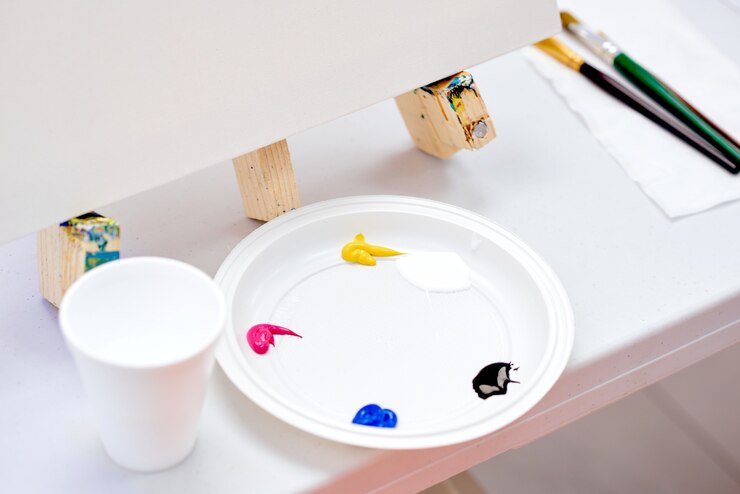How to Dispose of Acrylic Paint – Step by Step Guide 2024
Suppose you have done your acrylic painting projects and think it’s over. After finishing the project, you have to move to the next step, which is the disposal of acrylic paint tins. Several people throw paint cans in the dustbin without knowing the harmful effects.
How to Dispose of Acrylic Paint Easily
Knowing how to dispose of acrylic paint is crucial to avoid pollution. Some acrylic paints contain dangerous ingredients that shouldn’t be thrown away.
Here I provide complete details on getting rid of acrylic paint, particularly the dangerous varieties. I’ll also demonstrate how to distinguish between harmful paints and normal paints.
Why is Acrylic Harmful?
Several people are browsing the internet about whether acrylic paint is toxic itself or hazardous waste. Acrylic waste is considered harmful because it contains chemicals such as lead, cobalt, manganese, and other chemicals. These chemicals make the acrylic paint toxic, affecting the environment badly and causing disease in humans and animals.
In my experience, Acrylic paint only with water is not toxic, but the addition of chemicals makes them toxic. Generally speaking, Paints made of acrylic are not regarded as hazardous waste. The reality that they are non-toxic does not prove them environmentally friendly because most non-eco-friendly compounds are present in the material.
To protect your environment from the harm of acrylic paint, you should know where to dispose of used paint properly. Avoid throwing paint acrylic paint cans in the trash and if you throw, ensure that paint is solidified correctly and dried up.
Is Acrylic Paint Recyclable?
The question roaming on the internet is acrylic paint recyclable? As I mentioned above, acrylic paint can be toxic(containing harmful chemicals) or non-toxic(water-based paint). Non-toxic paints are recyclable.
There are a few terms when recycling is required. When you deliver it to a recycling center, they will screen and filter the paint after comparing it to quality criteria. They will then blend it with other paints that have a similar color and makeup to create recycled paint that others may use.
You should be familiar with the fact that not all recycling centers allow painting. Therefore, contact them to confirm whether the recycling center accepts paint or not for recycling.
If you do not like to go to the recycling center, you can choose another strategy: donate your leftover paint to an organization. You may donate it to a community theater company or a nearby school’s art or drama section or give it to your neighborhood Habitat for Humanity.
Some recycling centers are also performing this job. These recycling facilities will take acrylic paint and reserve it. It can then be given out to organizations that need it.

Fundamental Rule to Dispose Of the Acrylic Paint
Acrylic paint should generally be disposed of as a solid instead of a liquid. This will be your primary guideline for acrylic paint disposal. Throwing away wet paint is not a brilliant idea, even if you only dispose of a small quantity, like the remainder in a tiny tube.
Always leave the paint to dry thoroughly first. Fortunately, you only need a tiny bit of paint to accomplish that, like what’s left in a tiny paint tube. With more paint remaining, though, it might be a little trickier. But don’t fret. I’ll walk you through the procedures so you can effortlessly dispose of both small and large volumes of paint.
Steps To Get Rid Of Acrylic Paint
This guide will help you to dispose of acrylic paint safely.
1. Verify Your Area Regulation
It is essential to check out your local regulations because every state has different rules and laws for disposing of acrylic paint. This will help you to perform a job in a legal way (laws that are allowed in your area). If you have read the rules of your area, then move to step 2.
2. Search for a Drop-Off Site On Paintcare.Org
There is a unique service available to residents of specific states. Only ten states now provide it, but living under one of them will save you a lot of effort. The company providing the service is called PaintCare, and its website lists all of the drop-off sites. You can avoid going through the following six procedures by dropping paint off at PaintCare without first drying it off.
Of course, you won’t have access to this if you don’t live in one of the few states with PaintCare drop-off locations. You can proceed to step 3 after skipping this one if you’re not currently in one of those areas.
3. Avoid Throwing Away the Paint
Naturally, I throw waste products in garbage cans. But avoid throwing the acrylic paint cans in it. It is necessary to harden the paint even before wasting it in small amounts. So, collect all the leftover cans and let them harden.
4. Dry the Leftover Paint
To dry out the leftover paint, remove the lid of the cans and leave them. The sun and air will harden them. The hardening of paint also depends on the weather and the amount of paint. If the paint is in excess, it will demand more time to harden up.
There are preventive measures that you have to follow. If you keep cans open-air, ensure no animal or kids can mess with them. Also, cover the cans with the mesh lid to keep them away from children. And the last thing is to position it so that no one can easily access it.
It won’t take long if all you’re drying out leftovers in paint tubes. Remove the tubes’ tops and place them somewhere with fresh air. Paint cans with a net cover can be left open, and the increased exposure to air and sunlight will hasten their drying process. Therefore, make sure to locate paint cans in a protected yet visible area. Be careful when it rains, though. You can have a long wait if the rain starts through and wet your paint!
5. Add a Hardener
If you are dealing with paint tubes, you do not need to add anything, and the paint will dry quickly. But the scenario is not the same for paint cans. It will take longer to dry up if you have any leftover paint in cans. So, you have to add some hardener to speed up the process.
Several kinds of hardeners are available in your local store and online marketplace. You can purchase cat litter from any local store, which is a cheaper option and works effectively. Add the hardener or cat litter, and then put it in the sunlight. This will speed up your paint hardening process.
5. Wait Until It Hards
All you can do right now is wait. All are fully set up; all left is for the paint to dry. This process takes a few hours or a few days, based on how much paint you’re drying, the outside temperature, and whether or not you have a hardener. In either possibility, you have to wait until the paint is fully dry.
7. Throw Away The Hard Paint
You can take the paint from the can out or pail it once it has dried. You won’t have to take the paint out of the paint tubes if you’re drying them. Dispose of the paint. However, take the hard disc out if the paint is in a can or pail. You can throw it in the rubbish after removing it. It is now secure.
8. Recycle the Can
Recycling the can or pail is the last step in the procedure for proper disposal. Make sure the container is empty of paint before dropping it off at the recycling facility or placing it in your recycling bin for pickup.
How to Dispose of Acrylic Paint Water?
1. Don’t Flush Acrylic Rinse Water down The Drain
All of the acrylic paint in the paint brushes or rollers when you rinsed them is still in the water. Never pour the rinse water straight down the drain to stop this paint from entering the water supply or blocking your pipes. It would be best if you also refrained from dumping the rinse water on the ground, down a storm drain, or into a nearby river.
2. Fill the Bucket with Cat Litter Or Sand
A 5-US gal (19 L) bucket should be placed close to your painting materials. Then, add enough fresh kitty litter to fill the bucket halfway up the edge. Both clumping and non-clumping cat litter are available.
If you’d prefer, you could substitute sand for cat litter, but you’d need to wait many days or weeks for the washing water to evaporate.
3. Add the Rinse Water in the Pail
Pour all of your rinse water containers into the sand or cat litter gradually. While the water is soaked, you can detect the acrylic dye settling on the texture of the cat litter.
4. Throw Away the Cat Litter
Scoop up the colored cat litter using a rubber spatula or an immaculate cat litter scoop. Snatch up the clots if you tried clumping cat litter. Throw the cat litter in a plastic bag after that. Once closed, discard the bag in the garbage. The cat litter that is still in the bucket can be used. If the mixture appears watery, add fresh cat litter to the bucket.
Final Words- How to Dispose of Acrylic Paint
I hope that you understand enough about how to dispose of acrylic paint easily. Although you shouldn’t merely toss away wet paint containers or flush them down the toilet, doing so is still a simple process. Adhere to the straightforward instructions I’ve provided here, and you’ll be able to dispose of your old acrylic paint reliably.
Remember that if you have a lot of paint to get rid of, you can try donating it first. Even if you can’t find a purpose for that paint anymore, there are probably numerous groups that could.
